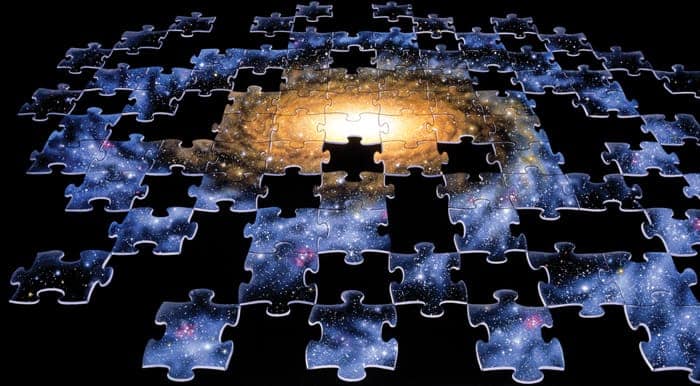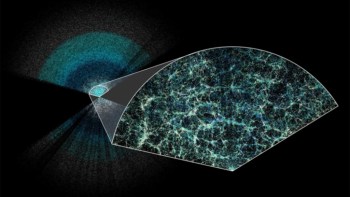
A distant galaxy apparently devoid of dark matter has been discovered by astronomers in the US, Canada and Germany. Paradoxically, they believe their finding could strengthen the case for dark matter as the source of the universe’s “missing mass” – because alternative theories that modify gravity should apply to all galaxies. Other researchers, however, remain unconvinced.
The idea that the universe might largely comprise “dark bodies” dates back to a talk given in 1884 by Lord Kelvin. In the 1930s, astrophysicists such as Fritz Zwicky realized the dynamics of galaxy clusters implied they contained far more mass than was visible to telescopes – mass that is now known as dark matter. More precise, observational evidence from Vera Rubin and colleagues was presented in 1980. Most astronomers now accept that only around 15% of the matter in the universe is “normal”, but the nature of the remainder remains largely mysterious.
Some astrophysicists, however, remain unconvinced. Pointing to several observations that dark matter struggles to explain, together with the fact that no one has yet identified dark matter, they argue that the underlying problem lies in the failure of current theories of gravity to correctly predict the large-scale dynamics of galaxies. Astrophysicist Pavel Kroupa of the University of Bonn in Germany, argued in 2012 that, if the dark-matter model were correct, there should be some “tidal dwarf galaxies” that, owing to having formed in a different way from other galaxies, did not contain dark matter. The absence of such galaxies would suggest that the dark-matter model is deficient.
Strange appearance
Pieter van Dokkum of Yale University and colleagues believe that their galaxy could fit the bill as a tidal dwarf devoid of dark matter. When studying the elliptical galaxy group NGC 1052 – around 63 million light-years from the Milky Way – with the Dragonfly Telephoto Array, which van Dokkum and a colleague built in New Mexico in 2013, the researchers noticed that a surrounding dwarf galaxy called NGC1052-DF2 looked very different in its Dragonfly images and in the Sloan Digital Sky Survey. “To try and find out what was going on, we applied for time on the Keck telescope and also took some images from the Hubble Space Telescope,” says van Dokkum.
Using the data, the researchers measured the brightnesses and rotation speeds of various clusters of stars within the galaxy. The researchers used the surface brightness fluctuation method, in which variation in the brightness of pixels arising from fluctuations in the specific number of stars’ light each pixel receives allows astronomers to calculate the brightness of single stars, and thereby to estimate the distance of the dwarf galaxy. Upon reaching the conclusion that it was indeed associated with NGC 1052 rather than sitting far in the foreground, they used measurements of the galaxy’s apparent luminosity, compared with its “true” luminosity, to estimate that the dwarf galaxy contained about 1.1×108 solar masses of stars.
Finally, they used the motions of the stars to calculate the amount of dark matter needed to explain the cluster motions observed. To their surprise, their results were consistent with there being no dark matter in the galaxy at all. The researchers suggest three possible formation scenarios for their surprising result. One is that they are observing a tidal dwarf galaxy that formed from normal matter that was liberated when much larger galaxies interact with each other. However, under all scenarios they conclude: “NGC1052–DF2 demonstrates that dark matter is not always coupled with baryonic matter on galactic scales.”
Stimulus to investigate
Kroupa is unconvinced, however: he notes that the dwarf galaxy appears extremely exotic, containing a number of unusually bright globular clusters (star clusters) but apparently no dimmer ones. “If the object is shifted toward the observer,” he says, “the gravitating mass will remain about the same, but the globular clusters and the galaxy become less luminous. So, the globular clusters can be brought into agreement with known globular clusters, the galaxy is less luminous for the same gravitating mass, and voila, we have dark matter in the object, which now is not exotic.”

What is the nature of the dark universe?
He concludes that “it’s a very stimulating paper, but I think that, given the importance of this type of argument, the exciting part is that maybe we can take this as a stimulus to investigate the surface brightness fluctuation method a bit more.” If the dwarf galaxy is associated with NGC 1052, however, he says the researchers need to calculate whether the external field effect – a non-linear effect in modified Newtonian dynamics (the main competitor to dark matter) – could explain the observations.
Dennis Zaritsky of the University of Arizona – whose observations of the Bullet Cluster are often cited as unambiguous proof of dark matter – is also sceptical. His own doubts, however, concern not the distance and luminosity measurements but the dynamical ones. “We’re now in this strange situation where the extraordinary claim is that something does not have dark matter rather than that it does,” he explains: “It’s an intriguing object and it’s worth pointing it out so that more work is done on it, but I think we’re not quite there yet.”
The observations are described in Nature.



